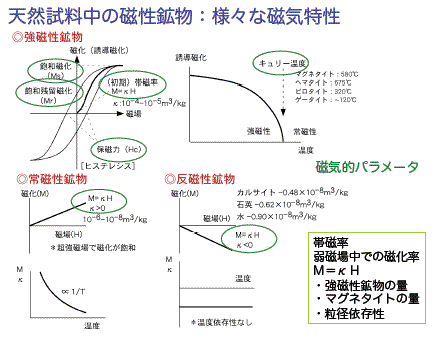/Image251.gif) FIGURE 1-3. Thermochemistry of pyrrhotite (at 1bar). The composition of pyrrhotite at high temperatures depends on fS2 and T, shown as isopleths of x values in Fe1-xS (gray, Toulmin and Barton 1964; Rau 1976). The pyrrhotite stability field is bounded by reactions forming iron (low fS2) and pyrite (high fS2). Pyrrhotite can undergo reactions with oxides and these can be used to formulate fS2 buffers, exemplarily shown for the fayalite-magnetite-quartz-pyrrhotite (Fa+Mag+Qz+Po) buffer (red dashed line, after Eggler and Lorand 1993). The buffer curve results from the intersection of equivalent fO2 isobars that relate to two basic reactions: Fe2O3 (Mag) + S2. 2FeS (Po) + 1.5O2 (blue isobars) and Fe2SiO4 (Fa) + S2 . 2FeS (Po) + SiO2 (Qz) + O2 (green isobars). The isobars are derived by relating the activity of FeS in Fe1-xS for given reaction, temperature, and fO2 to the x value and fS2 using the relations of Toulmin and Barton (1964) and Rau (1976). |
/Image266.gif) FIGURE 2-3. SEM-BSE images of the studied pyrrhotites. (a) Sta. Eulalia (EUL) showing two sets of dark exsolution lamellae of 4C-pyrrhotite in a matrix of NC-pyrrhotite. Adjacent dark areas are also 4C-pyrrhotite. (b) Nyseter (NYS) displaying two sets of dark 4C-pyrrhotite exsolution lamellae in NC matrix. (c) Tysfjord (TYS) displaying a single set of bright troilite (2C-pyrrhotite) exsolution lamellae parallel to (001). Faint lines and striations in (a-c) are artifacts from polishing and high detector gain. (d) Accumulated BSE image of TYS and extracted intensity profile showing dark haloes around troilite lamellae. Although the spatial extent of the BSE generating region causes a considerable convolution of the image, a clear low in backscattered intensity is visible around the lamella, pointing to an approximately 1 μm wide Fe depleted diffusion zone. |
/Image267.gif) FIGURE 2-7. SDF-TEM images obtained using the diffraction conditions shown in Fig. 2-6. (a) Sample EUL showing parallel and slightly undulating APBs imaged as dark stripes. (b) Sample NYS showing thicker dark stripes that are irresolvable doublets of two APBs. Arrows indicate areas in which stripe configuration is analogous to (a). Disorder of APB spacings and orientations is higher than in EUL. (c) Sample EUL. Interface between NC- and 4C-pyrrhotite showing termination of APBs in eightfold node structures. The behavior of APBs as doublets is apparent. (d) Sample NYS. Interface between NC- and 4C-pyrrhotite showing the same type of node structures as seen in EUL. Arrows indicate changes in configuration of APB doublets. (e) Sample EUL. Interface between NC- and 4C-pyrrhotite subparallel to (001). An eightfold node structure is seen within the APB stripes and the outermost APB doublet tilts away into the adjacent 4C-pyrrhotite. (f) Sample EUL. 4C lamella parallel to (001) with a large block of APBs tilting away from adjacent NC-pyrrhotite. |
/Image252.gif) FIGURE 3-2. Simplified, low temperature phase diagram of the Fe-S system based on Nakazawa and Morimoto (1970) and Kissin and Scott (1982). Many of the phase boundaries are tentative and shown dashed. 2C, 4C, 5C, 11C, 6C designate pyrrhotite superstructures with their c-dimension multiplicity of the fundamental NiAs-type cell. 2C is troilite, 4C is monoclinic pyrrhotite (Fe7S8 or Fe0.875S). 5C, 11C, and 6C are ‘hexagonal’ pyrrhotites (Fe9S10, Fe10S11, and Fe11S12, respectively). NC designates pyrrhotites with variable and often non-integral c dimension superstructure multiplicity, N values are given as dotted lines (Nakazawa and Morimoto 1970). 4.85C is a NC-pyrrhotite with non-integral multiplicity that commonly coexists with 4C-pyrrhotite at room temperature (Harries et al. 2011). MC- and NA-pyrrhotites are high temperature superstructures. 1C-pyrrhotite has completely disordered vacancies and a NiAs-type unit cell. |
/Image265.gif) FIGURE 4-1. (a) SEM-BSE image of EUL pyrrhotite. 4C-pyrrhotite forms exsolution lamellae in NC-pyrrhotite (N = 4.81.4.87) and occurs along fractures parallel to (001), likely due to pre-ferred nucleation. (b) SEM-BSE image of DAL pyrrhotite. Here the exsolution relationship is re-verse and NC-pyrrhotite (N = 4.90-4.92) occurs as small lamellae in 4C-pyrrhotite. (c) SDF-TEM image of a NC lamella in DAL pyrrhotite obtained using the preparation and imaging procedures described in Harries et al. (2011). Dark stripes in the NC portion are double filled iron layers, being equivalent to anti-phase domain boundaries (APBs), which terminate in complex node structures at the phase interface (cf. Harries et al. 2011). |
/Image264.gif) FIGURE 4-6. 3D topometry of pyrrhotite surfaces reacted in H2O2+H2SO4 solution at 35℃. (a) Detail of EUL {110} surface reacted for 13 hours at pH 2.05. The NC matrix dissolved faster than the 4C lamellae. (b) EUL {110} surface reacted for 44.3 hours at pH 2.90. 4C lamellae dissolved faster than the NC matrix and the total relief height is about one order of magnitude smaller compared to (a). Faint, parallel striations on the 4C surfaces are twin domains that reacted at slightly different rates. Non-parallel striations crossing the entire field of view are scratches from polishing. (c) DAL {110} surface reacted for 13 hours at pH 2.05. NC lamellae dissolved faster than the 4C matrix. (d) DAL {110} surface reacted for 44.3 h at pH 2.92. The 4C matrix dissolved faster than the NC lamellae. |
| Harries(2012)による『Structure and Reactivity of Terrestrial and Extraterrestrial Pyrrhotite』から | |
/Image250.gif)
/Image249.gif)
/Image263.gif)
/Image259.gif)
/Image260.gif)
/Image262.gif)
/Image261.gif)
/Image268.gif)
/Image247.gif)
/Image248.gif)
/Image276.gif)
/Image275.gif)
/Image277.gif)
/Image278.gif)
/Image283.gif)
/Image282.gif)
/Image281.gif)
/Image279.gif)
/Image280.gif)
/Image321.gif)
/Image322.gif)
/Image273.gif)
/Image274.gif)
/Image253.gif)
/Image255.gif)
/Image256.gif)
/Image257.gif)
/Image254.gif)
/Image258.gif)
/Image1388.gif)
/Image1387.gif)
/Image269.gif)
/Image1383.gif)
/Image1384.gif)
/Image332.gif)
/Image1385.gif)
/Image1378.gif)
/Image1379.gif)
/Image1386.gif)
/Image270.gif)
/Image272.gif)
/Image1381.gif)
/Image1382.gif)
/Image287.gif)
/Image286.gif)

/Image288.gif)
/Image289.gif)
/Image290.gif)
/Image291.gif)
/Image292.gif)
/Image293.gif)